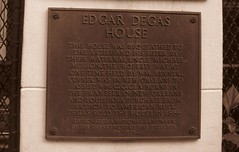Edgar Degas
(1834-1917)
Died aged c. 83
Wikidata WikipediaEdgar Degas (UK: /ˈdeɪɡɑː/, US: /deɪˈɡɑː, dəˈɡɑː/; born Hilaire-Germain-Edgar De Gas, French: [ilɛːʁ ʒɛʁmɛ̃ ɛdɡaʁ də ɡa]; 19 July 1834 – 27 September 1917) was a French Impressionist artist famous for his pastel drawings and oil paintings. Degas also produced bronze sculptures, prints and drawings. Degas is especially identified with the subject of dance; more than half of his works depict dancers. Although Degas is regarded as one of the founders of Impressionism, he rejected the term, preferring to be called a realist, and did not paint outdoors as many Impressionists did. Degas was a superb draftsman, and particularly masterly in depicting movement, as can be seen in his rendition of dancers and bathing female nudes. In addition to ballet dancers and bathing women, Degas painted racehorses and racing jockeys, as well as portraits. His portraits are notable for their psychological complexity and their portrayal of human isolation. At the beginning of his career, Degas wanted to be a history painter, a calling for which he was well prepared by his rigorous academic training and close study of classical art. In his early thirties he changed course, and by bringing the traditional methods of a history painter to bear on contemporary subject matter, he became a classical painter of modern life.
DbPedia
Commemorated on 1 plaque
Edgar Degas House. This house was bequeathed to the artist and his sister by their maternal uncle Michael Musson. The property was at one time held by Wm. Kenner. Kenner was in New Orleans to assist Wm.C.C. Claiborne in the transfer of New Orleans and Louisiana purchase from French to American Rule. Degas sold the house in 1866. Designated a National Landmark by the Department of the Interior in 1978.
307 Exchange Place, LA 70130, New Orleans, LA, United States where they was bequeathed this house and sold this house (1866)
